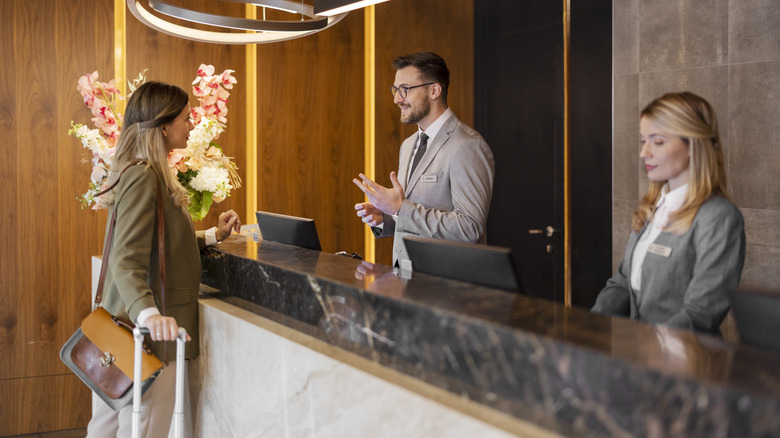Hotel check-out times have puzzled many travelers over the years. Why do most hotels require you to check out at 12:00 PM, while check-in doesn’t start until 2:00 PM or later? If you’ve assumed it’s just about cleaning, think again. The reasons for these standardized timings go beyond simple room preparation and reveal interesting insights about the hotel industry’s operations and guest convenience.
The Logic Behind Standard Check-In and Check-Out Times

Most hotels set check-in at 2:00 PM or later and check-out at 12:00 PM. While it might feel like you’re not getting a full 24-hour stay, this time frame is designed to strike a balance between operational efficiency and guest satisfaction.
- A Night’s Stay, Not a Full Day
Hotels operate on a “per-night” basis, not by the hour. This means they calculate a night’s stay starting from the afternoon of one day to midday of the next. For example, if you check in at 2:00 PM on Monday, your stay ends at 12:00 PM on Tuesday, regardless of whether you used the full 22 hours. - Avoiding Inconvenient Check-Out Times
Imagine checking out at 3:00 AM because you checked in at 5:00 AM. It’s impractical for both guests and hotels. By setting a standard 12:00 PM check-out, hotels ensure that guests can comfortably end their stay in the middle of the day without disrupting their schedules. - Booking Optimization
Hotels need to maintain a smooth flow of incoming and outgoing guests. Standardized times allow them to better manage room availability and ensure that rooms are ready for new arrivals without delays.
Why Hotels Leave a Two-Hour Gap Between Check-Out and Check-In
The two-hour window between check-out and check-in is a critical period for hotel staff to transition the room from one guest to the next. However, this gap isn’t just about cleaning; it’s about maintaining operational excellence and ensuring guest satisfaction.
- Thorough Room Inspections
Once a guest checks out, hotel staff conduct an inspection of the room. They check for damages, ensure all items provided by the hotel are accounted for, and note any minibar consumption or additional charges. This process ensures the room is in top condition for the next guest. - Professional Cleaning Standards
Room cleaning is a meticulous process that goes beyond tidying up. Housekeeping staff typically follow these steps:- Vacuuming and Dusting: The room is vacuumed, and surfaces like tables and shelves are wiped down.
- Replacing Linens: Fresh bed linens and pillowcases are laid out to provide a clean, comfortable sleeping experience.
- Sanitizing Bathrooms: The bathroom, often the dirtiest area, is thoroughly cleaned, sanitized, and restocked with toiletries.
- Checking Appliances: Devices such as TVs, air conditioners, and water heaters are tested to ensure functionality.
- Final Touches: Glassware is replaced, curtains are adjusted, and the room is inspected for overall presentation.
- Room Assignment and Preparation
While cleaning happens, hotel management updates room assignments for incoming guests. Any specific requests, such as adjoining rooms or special amenities, are coordinated during this time.
Guest Convenience: A Hidden Benefit
While the 12:00 PM check-out and 2:00 PM check-in times may seem arbitrary, they’re designed with guest convenience in mind.

- A Relaxed Morning
Guests have the entire morning to pack, enjoy breakfast, or prepare for their departure without feeling rushed. This mid-day timing ensures that guests can transition smoothly to their next destination. - Consistency Across the Industry
By aligning check-out and check-in times across most hotels, travelers experience consistency. Whether staying at a budget inn or a luxury resort, they can plan their schedules without needing to confirm specific policies for each location.
The Practical Side for Hotels
For hotels, maintaining this timing structure ensures a streamlined operation and allows them to maximize efficiency.
- Time to Manage Unexpected Delays
If a guest checks out late or an issue arises during cleaning, the two-hour window provides a buffer to address these delays without affecting incoming guests. - Flexibility for Early Check-Ins or Late Check-Outs
Many hotels offer early check-in or late check-out for an additional fee. The standardized times allow them to accommodate these requests without disrupting their regular schedule. - Preparing for Peak Seasons
During busy periods, such as holidays or events, the gap between check-out and check-in becomes even more essential. It ensures that hotels can handle increased guest turnover while maintaining quality service.
Exceptions to the Rule

While 12:00 PM check-out and 2:00 PM check-in are standard, some hotels offer more flexible options. Boutique hotels, extended-stay properties, and luxury resorts may allow later check-out times or earlier check-ins, especially for loyal customers or those who request special accommodations.
However, such flexibility often depends on room availability and the hotel’s capacity to manage these changes without compromising service quality.
How Guests Can Make the Most of Their Stay
Understanding the reasoning behind these timings can help travelers better plan their stays. Here are some tips to maximize your hotel experience:
- Request Early Check-In or Late Check-Out
If you arrive early or need extra time, contact the hotel in advance. Many properties will accommodate your request, sometimes for free or a small fee. - Use Amenities During the Transition Period
If your room isn’t ready yet or you’ve already checked out, take advantage of hotel amenities like the lounge, gym, or luggage storage. - Plan Around Check-In and Check-Out Times
Align your travel schedule with hotel timings to avoid unnecessary waiting. For example, plan flights and activities that coincide with check-in or check-out hours.
Conclusion: A System That Balances Efficiency and Comfort
The 12:00 PM check-out and 2:00 PM check-in times aren’t just about cleaning—they’re about creating a seamless experience for guests while optimizing hotel operations. This system ensures rooms are ready, guest transitions are smooth, and the overall stay remains enjoyable.
So, the next time you’re checking out at noon or waiting to check in at 2:00 PM, remember that there’s a lot more going on behind the scenes than meets the eye. It’s all part of a well-oiled machine designed to provide the best experience for every traveler.


